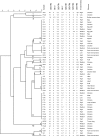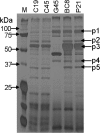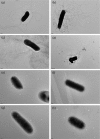Cell invasion of poultry-associated Salmonella enterica serovar Enteritidis isolates is associated with pathogenicity, motility and proteins secreted by the type III secretion system
- PMID: 21292746
- PMCID: PMC3140581
- DOI: 10.1099/mic.0.044461-0
Cell invasion of poultry-associated Salmonella enterica serovar Enteritidis isolates is associated with pathogenicity, motility and proteins secreted by the type III secretion system
Abstract
Salmonella enterica serovar Enteritidis (S. Enteritidis) is a major cause of food-borne gastroenteritis in humans worldwide. Poultry and poultry products are considered the major vehicles of transmission to humans. Using cell invasiveness as a surrogate marker for pathogenicity, we tested the invasiveness of 53 poultry-associated isolates of S. Enteritidis in a well-differentiated intestinal epithelial cell model (Caco-2). The method allowed classification of the isolates into low (n = 7), medium (n = 18) and high (n = 30) invasiveness categories. Cell invasiveness of the isolates did not correlate with the presence of the virulence-associated gene spvB or the ability of the isolates to form biofilms. Testing of representative isolates with high and low invasiveness in a mouse model revealed that the former were more invasive in vivo and caused more and earlier mortalities, whereas the latter were significantly less invasive in vivo, causing few or no mortalities. Further characterization of representative isolates with low and high invasiveness showed that most of the isolates with low invasiveness had impaired motility and impaired secretion of either flagella-associated proteins (FlgK, FljB and FlgL) or type III secretion system (TTSS)-secreted proteins (SipA and SipD) encoded on Salmonella pathogenicity island-1. In addition, isolates with low invasiveness had impaired ability to invade and/or survive within chicken macrophages. These data suggest that not all isolates of S. Enteritidis recovered from poultry may be equally pathogenic, and that the pathogenicity of S. Enteritidis isolates is associated, in part, with both motility and secretion of TTSS effector proteins.
Figures






Similar articles
-
Transposon mutagenesis of Salmonella enterica serovar Enteritidis identifies genes that contribute to invasiveness in human and chicken cells and survival in egg albumen.Infect Immun. 2012 Dec;80(12):4203-15. doi: 10.1128/IAI.00790-12. Epub 2012 Sep 17. Infect Immun. 2012. PMID: 22988017 Free PMC article.
-
Evaluation of virulence and antimicrobial resistance in Salmonella enterica serovar Enteritidis isolates from humans and chicken- and egg-associated sources.Foodborne Pathog Dis. 2013 Dec;10(12):1008-15. doi: 10.1089/fpd.2013.1518. Epub 2013 Oct 8. Foodborne Pathog Dis. 2013. PMID: 24102082
-
Salmonella enterica serovar enteritidis pathogenicity island 1 is not essential for but facilitates rapid systemic spread in chickens.Infect Immun. 2009 Jul;77(7):2866-75. doi: 10.1128/IAI.00039-09. Epub 2009 Apr 13. Infect Immun. 2009. PMID: 19364835 Free PMC article.
-
The chicken, the egg and Salmonella enteritidis.Environ Microbiol. 2001 Jul;3(7):421-30. doi: 10.1046/j.1462-2920.2001.00213.x. Environ Microbiol. 2001. PMID: 11553232 Review.
-
Pathogenicity of Salmonella enteritidis in poultry.Int J Food Microbiol. 1994 Jan;21(1-2):89-105. doi: 10.1016/0168-1605(94)90203-8. Int J Food Microbiol. 1994. PMID: 8155481 Review.
Cited by
-
Naturally occurring motility-defective mutants of Salmonella enterica serovar Enteritidis isolated preferentially from nonhuman rather than human sources.Appl Environ Microbiol. 2011 Nov;77(21):7740-8. doi: 10.1128/AEM.05318-11. Epub 2011 Sep 16. Appl Environ Microbiol. 2011. PMID: 21926214 Free PMC article.
-
Efficacy evaluation of commercial disinfectants by using Salmonella enterica serovar Typhimurium as a test organism.J Vet Sci. 2017 Jun 30;18(2):209-216. doi: 10.4142/jvs.2017.18.2.209. J Vet Sci. 2017. PMID: 27586462 Free PMC article.
-
Virulence potential of Salmonella 1,4, [5],12:i:- strains isolated during decades from different sources in the Southeast region of Brazil.Braz J Microbiol. 2023 Dec;54(4):2827-2843. doi: 10.1007/s42770-023-01145-5. Epub 2023 Oct 10. Braz J Microbiol. 2023. PMID: 37817050 Free PMC article.
-
Dimethyl adenosine transferase (KsgA) deficiency in Salmonella enterica Serovar Enteritidis confers susceptibility to high osmolarity and virulence attenuation in chickens.Appl Environ Microbiol. 2013 Dec;79(24):7857-66. doi: 10.1128/AEM.03040-13. Epub 2013 Oct 11. Appl Environ Microbiol. 2013. PMID: 24123731 Free PMC article.
-
Serotype Occurrence, Virulence Profiles, Antimicrobial Resistance and Molecular Characterization of Salmonella Isolated from Hospitalized Patients with Gastroenteritis in Great Tunisia between 2010 and 2020.Antibiotics (Basel). 2023 Mar 6;12(3):526. doi: 10.3390/antibiotics12030526. Antibiotics (Basel). 2023. PMID: 36978394 Free PMC article.
References
-
- Agron P. G., Walker R. L., Kinde H., Sawyer S. J., Hayes D. C., Wollard J., Andersen G. L. (2001). Identification by subtractive hybridization of sequences specific for Salmonella enterica serovar Enteritidis. Appl Environ Microbiol 67, 4984–4991. 10.1128/AEM.67.11.4984-4991.2001. - DOI - PMC - PubMed
-
- Alvarez J., Sota M., Vivanco A. B., Perales I., Cisterna R., Rementeria A., Garaizar J. (2004). Development of a multiplex PCR technique for detection and epidemiological typing of Salmonella in human clinical samples. J Clin Microbiol 42, 1734–1738. 10.1128/JCM.42.4.1734-1738.2004. - DOI - PMC - PubMed
Publication types
MeSH terms
Substances
Grants and funding
LinkOut - more resources
Full Text Sources
Medical

